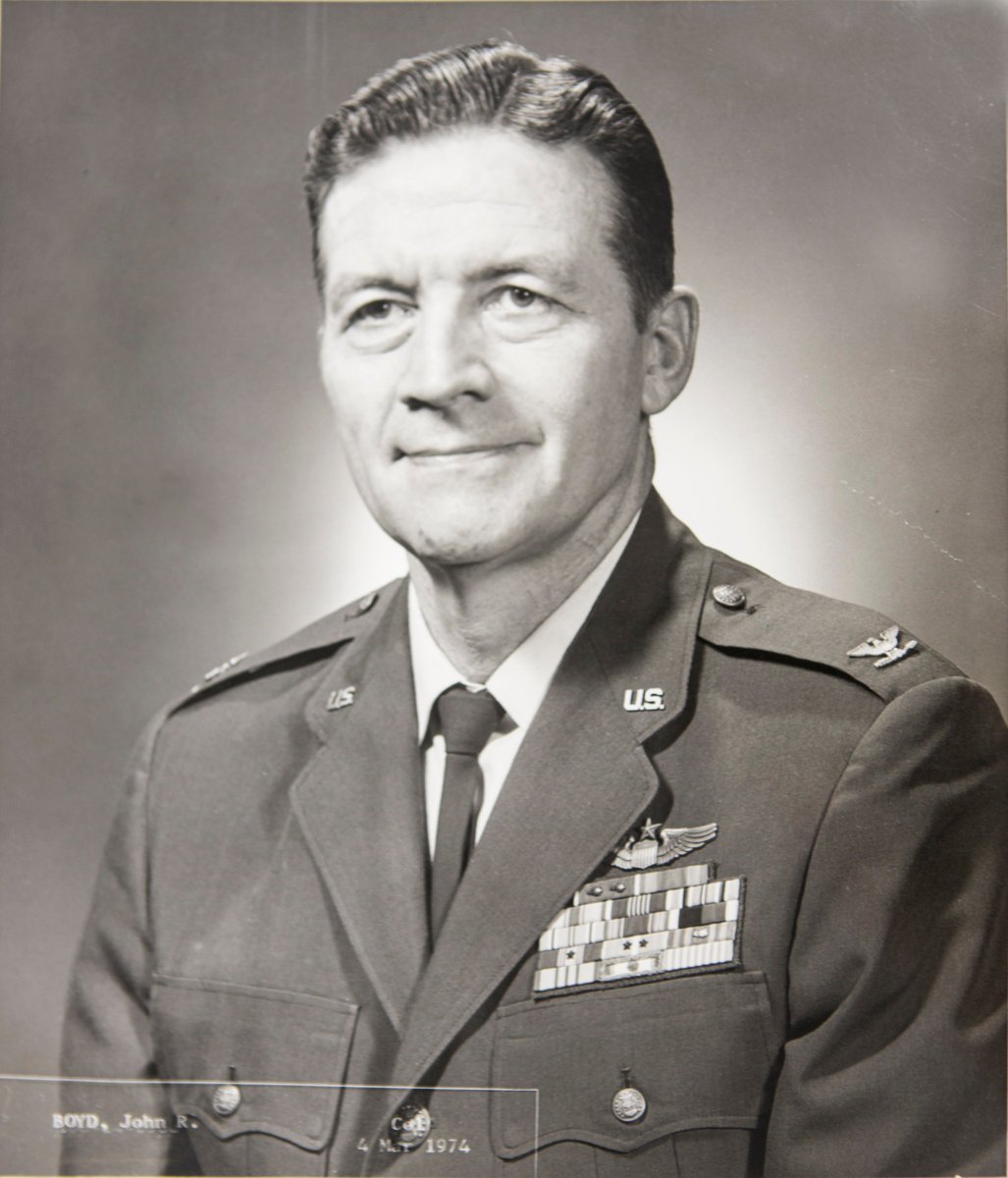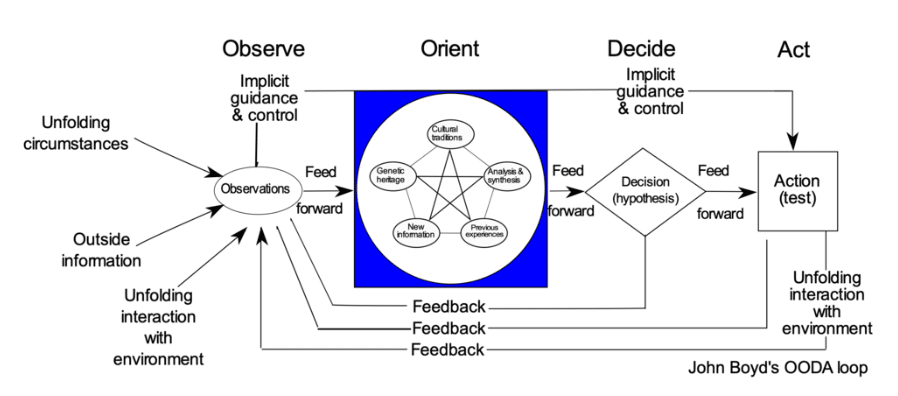Evolving Needs and Designs to Meet Them
Desiring a lightweight fighter, absent of “swing wing” design (like the F-111 and F-14 concepts), Boyd worked on design specifications. Ultimately losing to the military appropriations machine, the F-X became the F-15 and Boyd’s inputs kept the overall weight lower than the Air Force originally desired. A new need developed for a close air support (CAS) platform. Boyd met Pierre Sprey, a civilian analyst with whom he shared a mutual distaste for the eventual F-X, but would team together for the A-X project.

The A-X
While a true fighter pilot such as Boyd naturally dismissed close air support, Sprey actively sought Boyd’s assistance with the creation of perhaps the most influential specialized combat aircraft ever built- the A-10 Thunderbolt II. Sprey utilized Boyd’s E-M charts to design a close air support aircraft with unparalleled capabilities that were finally conclusively proven during the Gulf War. Boyd reviewed Sprey’s work, but remained passive no matter how much Sprey tried to include Boyd. According to Sprey, Boyd would simply pat him on the back and say “You’re doing great tiger, keep it up.”

The Fighter Mafia is Born
After “losing” the new F-X for a more lightweight and maneuverable aircraft, Boyd found a partner in fellow fighter pilot Colonel Everett Riccioni. Riccioni was in charge of Research and Development and philosophically agreed with Boyd and Sprey regarding a smaller single engine fighter aircraft. As a previous WWII fighter pilot, aeronautical engineer, Air Force Academy instructor, and now Pentagon worker, Riccioni joined Sprey and Boyd to become the “Fighter Mafia” as they worked on a new advanced fighter design flying under the radar of leadership.

The Fighter Mafia Evolves
Thanks to the Mafia group’s dedication to its virtues the lightweight fighter program gradually developed. Boyd was promoted to Colonel and transferred to Thailand for a command tour before returning to the Pentagon. Upon his return to the CONUS Boyd championed the new lightweight fighter with new members of the Mafia- Dr. Ray Leopold and Chuck Spinney. Their time, effort, and dedication toward this aircraft led to the F-16 and books could be written about the red tape, obstacles, and challenges that rose and fell before production.

Conjuring Patterns of Conflict
Boyd retired in 1975 after 24 years of service to focus on new areas of aeronautical and tactical thought. He spent that first year of retirement simply reading and understanding war, which lead to perhaps his most intellectual idea. Boyd developed a six-hour briefing entitled Patterns of Conflict- essentially a summary of ground warfare history. Boyd condensed and studied major historical battles and relationships with war strategists such as Sun Tzu and Carl von Clausewitz.

OODA Looping the Top Brass
Boyd generated the Observe-Orient-Decide-Act (OODA) loop. The Loop step is a bit of a misnomer as the cycle may include hundreds of inputs and/or simply result in observe to act. The intent of the decision process in war is to facilitate rapid actions that leave the opposing force unable to react. From the late 1970s to the present day the OODA loop symbolizes one of the greatest contributions to war. Boyd briefed Patterns to notable future influential personnel such as Sam Nunn and Dick Cheney.

Boyd the Marine
In 1980, an instructor at the Marine Amphibious Warfare School, Major Mike Wyly, was tasked to change and update the Corps’ tactics and doctrine as then taught. Wyly asked Boyd to provide a two hour brief on Patterns for the class. Boyd responded that the brief would be five hours or none. Relenting, Wyly let Boyd deliver the Patterns brief to the young marines. Wyly immediately understood the importance and change-effect outlined in the Patterns brief. Not only did the young marines finish the brief, they continued asking questions of this former Air Force fighter pilot about conducting ground warfare.

Applying Lessons on the Battlefield
The Gulf War validated many concepts and methods instilled in the marine forces regarding maneuver warfare. Marines rapidly advanced and Iraqi army units surrendered because they were unable to react to the quick advancement. Boyd’s impact upon the Marine Corps resulted in his becoming the only Air Force member with a dedicated exhibit at the Marine Corps Research Center at Quantico in Virginia.

On Boyd
John Boyd remains one of the most influential, controversial, cigar-smoking, foul-mouthed legendary fighter pilots ever to exist. His legacies of Aerial Attack Study, the OODA Loop, and Patterns of Conflict continue to educate those willing to read and study. Boyd mastered the Pentagon bureaucracy and was a brilliant tactician in finding ways to make airplanes, people, and projects better for the Defense Department. He passed away in 1997 from cancer, but his impacts upon aviation and ground warfare solidify his life achievements.
Stay tuned for more in this series about the Fighter Mafia!
Below is from Erie, PA, recognizing John Boyd’s life.

Nicely written Chris. Enjoyable read.
Chris, happy to see you are interested in Boyd’s work. Excellent effort calling attention to Boyd. Did you know Boyd? Robert Coram’s book on Boyd is great resource and reference.
Chris, I enjoyed your article. I first met John at NKP, Task Force Alpha. He was Vice Commander and I was Chief of the Strike Branch. We spent many hours tutoring me on his theories and life in general. One afternoon I met a visiting F-4 pilot at the Officers Club and during our conversation I asked him about Energy Maneuverability. The pilot remarked he had heard of it but didn’t know much about it. I told him he was in luck as I noticed Col.Boyd coming into the room. I called John over and introduced him to the visiting pilot and said the pilot wanted to know about EM. I then left.
The next day when Col. Boyd came into my office at TFA I asked him how his conversation with the visiting F-4 pilot went. John said he was amazed that they were not teaching new pilots more about EM. I told him that there were several squadrons of fighter pilots in Thailand that would benefit from his first hand experience.
I didn’t see Col Boyd for a few weeks after that as he was in Korat and Udorn teaching classes on EM.
After NKP we both went to the Pentagon and I had a chance to review many of his draft briefings he developed on the OODA loop.
John Boyd was one of the most focused men I met in the Air Force. He was all business, his business. He had his vision of life and would gladly help you if you were working toward the same goal.
Lt. Col. Steve Schuneman, USAF Retired
Thank you for the inputs. I did not know him and I read Coram’s book several times. That book provided the motivation for writing about these historical figures that literally shaped our aircraft inventory through their diligence and perseverance.
Thanks Mike – you’re the awesome instructor that trained me through the Private’s license!
Thank you for the anecdote! What an excellent story relating your relationship with Boyd and through your direct influence – impacted those in theater!
Colonel Joseph Rogers, best known as an SR-71 pilot, claims to have “waxed his ass” at Nellis. My dad flew under his command in the 71st fighter squadron. The quote was from the note on the title page of the Boyd biography Colonel Rogers sent to my dad to read.
Don’t know if he collected $40 from Boyd.
[…] Fighter Mafia: Colonel John Boyd, The Brain Behind Fighter Dominance […]